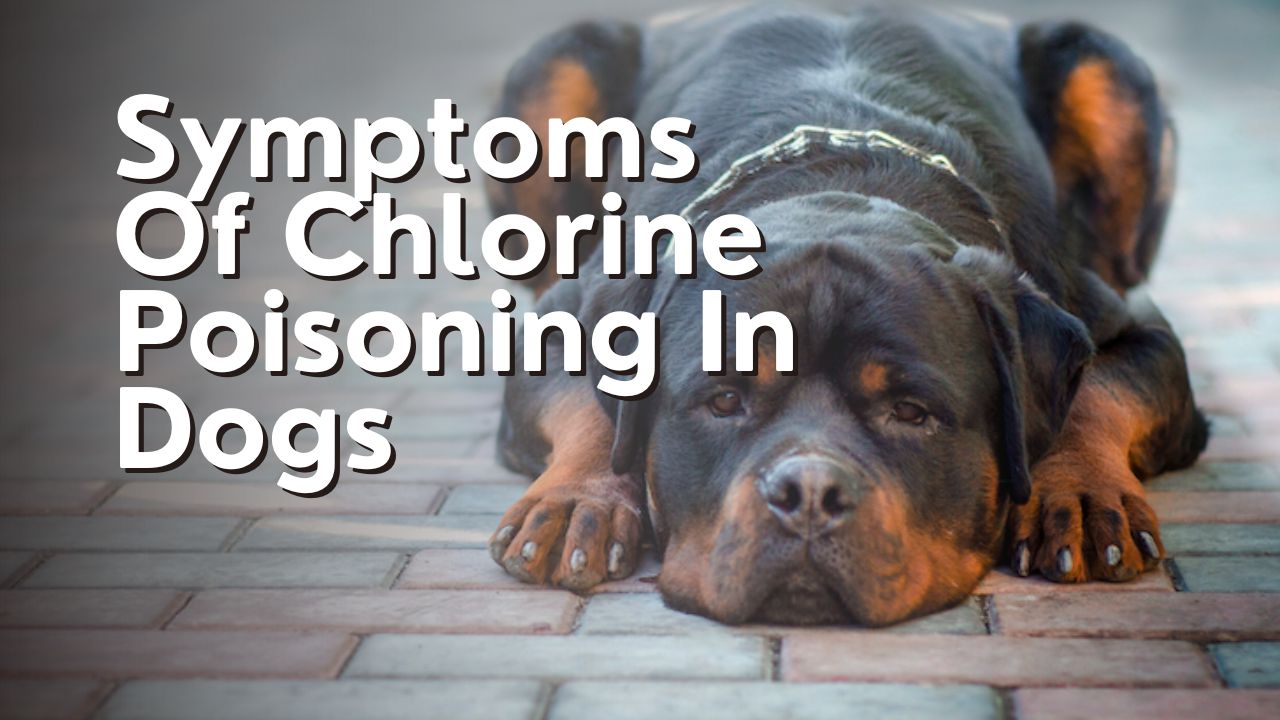Hey there, folks! Have you ever wondered what the symptoms of chlorine poisoning are in dogs? Well, wonder no more because I’ve got you covered.
In this article, we’ll be diving into the common causes of chlorine poisoning in our furry friends and the telltale signs to look out for.
Picture this: you’re at the pool, enjoying a nice swim with your pooch, when suddenly you notice something’s not right. Your dog starts coughing and wheezing, or maybe they’re experiencing some digestive distress. These could be signs of chlorine poisoning, and it’s important to be aware of them.
We’ll also be discussing the skin irritation and allergic reactions that can occur as a result of chlorine exposure.
And don’t worry, I’ve got your back on what steps to take if your dog shows any of these symptoms. So, stay tuned and let’s make sure our furry companions are safe and sound around chlorine!
Common Causes of Chlorine Poisoning in Dogs
One of the most common causes of chlorine poisoning in dogs is when they ingest water from swimming pools or hot tubs that have been treated with excessive amounts of chlorine. This can happen when dogs accidentally drink from these sources while playing or swimming. Dogs are naturally curious creatures and may not realize that the water they are consuming contains harmful chemicals.
Chlorine poisoning occurs when dogs consume or come into contact with high levels of chlorine. The symptoms can vary depending on the severity of the poisoning. Mild cases may result in gastrointestinal distress, such as vomiting and diarrhea. More severe cases can lead to respiratory issues, including coughing, wheezing, and difficulty breathing. Dogs may also experience skin irritation, redness, and itching.
It is important for dog owners to be aware of the signs of chlorine poisoning and seek immediate veterinary care if they suspect their dog has been exposed. Treatment may involve inducing vomiting to remove any remaining chlorine from the dog’s system and providing supportive care to alleviate symptoms. Prevention is key, so it is essential to ensure that dogs do not have access to water sources treated with excessive chlorine and to provide fresh, clean water for them to drink.

Respiratory Symptoms to Look Out For
Beware of any unusual breathing difficulties your furry companion may experience after exposure to chlorine. It is important to be vigilant and keep an eye out for any respiratory symptoms that may indicate chlorine poisoning in dogs.
Dogs who have been exposed to chlorine may exhibit signs such as coughing, wheezing, and labored breathing. They may also develop a runny nose or excessive nasal discharge. If you notice any of these symptoms, it is crucial to seek immediate veterinary attention.
Chlorine poisoning can cause irritation and inflammation in the respiratory system of dogs, leading to difficulty breathing. This can be particularly dangerous for dogs with pre-existing respiratory conditions, such as asthma or bronchitis. In severe cases, dogs may experience cyanosis, a condition characterized by a bluish discoloration of the skin and mucous membranes due to lack of oxygen. If you observe this symptom, it is a medical emergency and you should rush your dog to the veterinarian right away.
Remember, prevention is key when it comes to chlorine poisoning in dogs. Always ensure that your dog is not exposed to excessive amounts of chlorine, especially in poorly ventilated areas. If you suspect your dog has been exposed to chlorine or is showing any respiratory symptoms, don’t hesitate to seek professional help. Your furry friend’s health and well-being should always be a top priority.
Gastrointestinal Symptoms and Digestive Distress
Pay attention to any signs of digestive distress that your furry companion may show after being exposed to chlorine, such as stomach upset, diarrhea, or vomiting. These gastrointestinal symptoms can occur if your dog ingests or inhales chlorine. This can happen through direct contact with pool water or by drinking from a chlorinated source. It is important to recognize these signs early on, as they can indicate chlorine poisoning in dogs.
Stomach upset is a common symptom of chlorine poisoning in dogs. You may notice that your dog’s stomach is gurgling or making unusual noises. They may also show signs of discomfort, such as pacing or restlessness.
Additionally, diarrhea is another common digestive symptom. Your dog may have loose or watery stools, or they may have increased frequency of bowel movements. Vomiting may also occur, ranging from occasional episodes to persistent and severe. If you notice any of these symptoms, it is crucial to seek veterinary attention immediately.
In some cases, chlorine poisoning can lead to more severe gastrointestinal symptoms, such as abdominal pain or bloating. Your dog may also refuse to eat or drink, which can lead to dehydration. These symptoms can be indicative of a more serious condition and should be treated promptly by a veterinarian.
Remember, early recognition of digestive distress is key in ensuring your dog receives the necessary care and treatment.
Skin Irritation and Allergic Reactions
If your furry companion is exposed to chlorine, you may experience skin irritation and allergic reactions. Just like humans, dogs can have sensitive skin that reacts negatively to certain substances. When chlorine comes into contact with your dog’s skin, it can cause redness, itching, and even rashes. These symptoms can be uncomfortable for your dog and may cause them to scratch excessively, leading to further skin irritation and potential wounds.
Allergic reactions to chlorine can also occur in dogs. This happens when your dog’s immune system overreacts to the chlorine, mistaking it as a harmful substance. The allergic reactions can range from mild to severe and may include symptoms such as hives, swelling, and difficulty breathing. In severe cases, an allergic reaction to chlorine can be life-threatening and require immediate veterinary attention.
To help alleviate skin irritation and allergic reactions in your dog, it is important to rinse them thoroughly with clean water after they have been exposed to chlorine. Avoid using harsh soaps or shampoos, as these can further irritate their skin. If your dog shows signs of an allergic reaction, such as difficulty breathing or swelling, seek veterinary care immediately.
Remember, prevention is key when it comes to protecting your dog from chlorine poisoning. Be mindful of their exposure to chlorine and take necessary precautions to keep them safe and healthy.
Steps to Take if Your Dog Shows Signs of Chlorine Poisoning
When your furry friend starts displaying unusual behavior, such as excessive panting and lethargy, it’s important to be aware of the potential signs of chlorine poisoning. If you suspect that your dog may have been exposed to chlorine and is showing symptoms, here are some steps you can take to help them:
- Stay calm and assess the situation: Take a moment to observe your dog’s behavior and assess the severity of the symptoms. It’s important to stay calm and not panic, as this can only escalate the situation.
- Remove your dog from the source: If your dog is showing signs of chlorine poisoning, it’s crucial to remove them from the area where they were exposed to the chlorine. This could be a swimming pool, a cleaning solution, or any other source of chlorine.
- Contact your veterinarian: Reach out to your veterinarian immediately and inform them about the situation. They will be able to provide you with further guidance and advise you on the next steps to take.
Remember, the best way to prevent chlorine poisoning in dogs is to keep them away from chlorinated areas. If your dog does come into contact with chlorine, keep a close eye on them and seek veterinary attention if you notice any unusual symptoms.

Frequently Asked Questions
Can a dog be exposed to chlorine poisoning even if they don’t swim in a pool?
Yes, a dog can be exposed to chlorine poisoning even if they don’t swim in a pool. Chlorine can be present in cleaning products, tap water, or even inhaled from nearby pools, causing potential poisoning.
Are there any long-term effects of chlorine poisoning in dogs?
There don’t appear to be any long-term effects of chlorine poisoning in dogs. While it can cause immediate symptoms, such as vomiting and difficulty breathing, these typically resolve once the dog is no longer exposed to chlorine.
Can chlorine poisoning in dogs be fatal?
Yes, chlorine poisoning in dogs can be fatal. It’s important to seek immediate veterinary care if you suspect your dog has been exposed to chlorine, as it can lead to serious complications, organ damage, and even death.
Are certain dog breeds more susceptible to chlorine poisoning?
Certain dog breeds may be more susceptible to chlorine poisoning due to their size, respiratory sensitivity, and overall health. However, it is important to note that all dogs can be at risk, regardless of breed.
What immediate first aid measures can be taken at home if a dog shows signs of chlorine poisoning?
If a dog shows signs of chlorine poisoning, the first thing I would do is remove them from the source of exposure. Then, I would rinse their fur with clean water and contact a veterinarian for further guidance and treatment.
Conclusion
In conclusion, if your dog shows any signs of chlorine poisoning, it’s important to take immediate action.
Monitor their respiratory symptoms, such as coughing or difficulty breathing, and seek veterinary attention if necessary.
Keep an eye out for gastrointestinal symptoms like vomiting or diarrhea, and provide them with plenty of water to drink.
Additionally, if your dog experiences any skin irritation or allergic reactions, consult with a veterinarian for appropriate treatment.
Remember, early intervention is crucial in ensuring your dog’s health and well-being.


